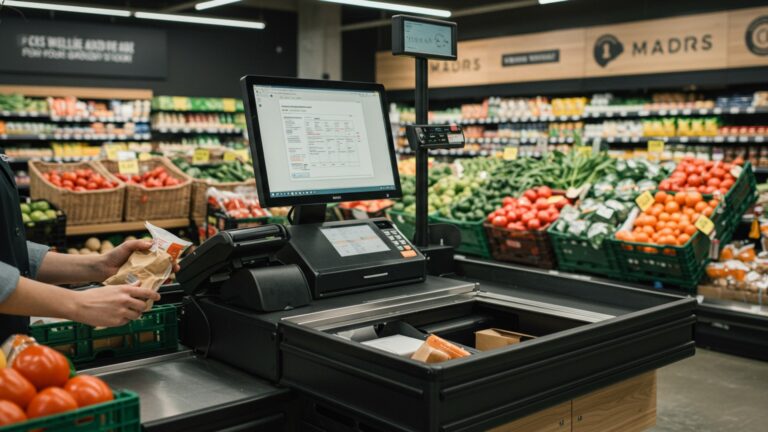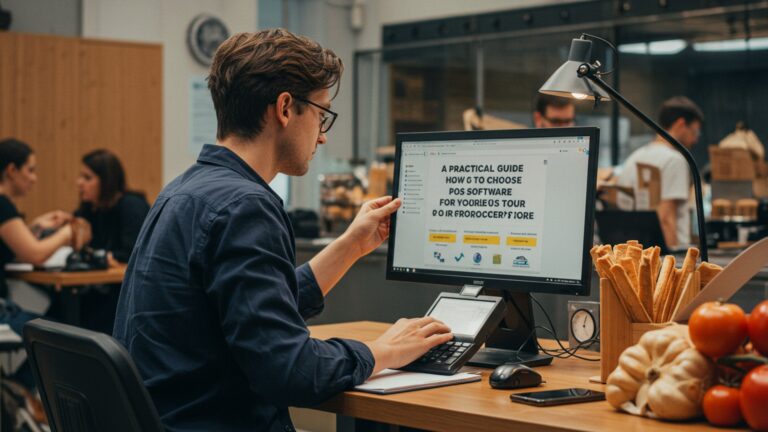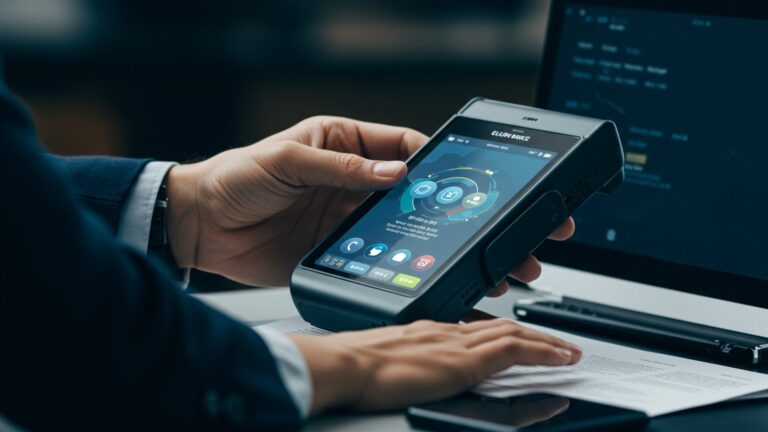Unleash Business Mobility How to Implement Mobile POS Software Solutions Seamlessly
The modern retail and service landscape demands unparalleled agility, pushing businesses beyond static checkout counters. Implementing robust mobile POS software solutions now defines operational efficiency, transforming how companies engage customers and manage sales. Consider a bustling pop-up shop at a festival or a field technician completing a service call: real-time inventory updates, secure contactless payments. instant receipt generation are no longer luxuries but essentials for seamless operations. Recent advancements, from cloud-native platforms integrating with dynamic CRM systems to AI-driven sales analytics accessible on handheld devices, underscore a critical shift. Businesses effectively harness these technologies to unlock unprecedented mobility, enhance customer satisfaction. gain vital operational insights, moving beyond mere transaction processing to comprehensive business management on the go.
Understanding Mobile POS Software: The Backbone of Modern Business Mobility
In today’s fast-paced commercial landscape, the ability to conduct transactions anywhere, anytime, has become not just a luxury but a necessity. This is where mobile POS software steps in as a transformative technology. At its core, a Mobile Point of Sale (POS) system transforms a smartphone, tablet, or dedicated mobile device into a complete cash register, capable of processing sales, managing inventory. tracking customer data on the go. Unlike traditional, stationary POS terminals that tether businesses to a counter, mobile POS software liberates operations, offering unparalleled flexibility.
The evolution from bulky, static cash registers to sleek, portable mobile POS software solutions reflects a broader shift towards digitization and customer-centric service. Early POS systems were essentially glorified calculators with cash drawers. The advent of personal computers brought more sophisticated inventory and sales tracking. Now, with the ubiquity of mobile devices and robust cloud infrastructure, mobile POS software has pushed the boundaries further, integrating seamlessly into existing business ecosystems.
Key components typically involved in a mobile POS setup include:
- Mobile Device
- Card Reader
- Receipt Printer
- Barcode Scanner
- Cash Drawer
- Cloud-Based Backend
A smartphone or tablet (iOS or Android) running the dedicated mobile POS software application.
Often a small, attachable device that connects to the mobile device, allowing for EMV chip, NFC (contactless), or traditional magnetic stripe payments.
A compact, often Bluetooth-enabled thermal printer for physical receipts, though email or SMS receipts are increasingly common.
Can be integrated into the mobile device’s camera or a separate, handheld scanner for quick product lookup.
An optional. often useful, component for businesses handling cash transactions.
The central hub where all transaction data, inventory levels, customer insights. sales reports are stored and managed. This is crucial for real-time synchronization across multiple devices and locations.
The beauty of mobile POS software lies in its ability to empower businesses of all sizes, from bustling food trucks to multi-location retail chains, to operate with greater efficiency, enhance customer experiences. gain deeper insights into their sales performance.
Why Mobile POS is a Game-Changer for Modern Businesses
The adoption of mobile POS software is not merely an upgrade; it’s a strategic move that fundamentally redefines how businesses interact with customers and manage their operations. Its impact spans across various facets, offering distinct advantages that traditional systems simply cannot match.
- Enhanced Mobility and Flexibility
- Improved Customer Experience
- Increased Efficiency and Sales
- Data-Driven Insights
- Cost-Effectiveness
- Streamlined Inventory Management
This is the most obvious benefit. Whether it’s a server taking orders tableside, a salesperson closing a deal on the showroom floor, or an artisan selling wares at a craft fair, mobile POS software allows transactions to occur wherever the customer is. This eliminates queues, speeds up service. provides a more personal buying experience. Consider the example of a coffee shop during peak hours: instead of a single bottleneck at the counter, staff can take orders and payments on tablets, significantly reducing wait times and improving customer satisfaction.
By bringing the point of sale directly to the customer, businesses can offer personalized service, answer questions on the spot. complete sales without customers needing to move to a designated checkout area. This seamless interaction fosters loyalty and convenience. Imagine a fashion retailer whose associates can instantly check inventory, suggest complementary items. process a payment for a customer right in the fitting room.
Faster transaction processing means more sales in less time. Real-time inventory updates prevent overselling and streamline stock management. Mobile POS software often includes features like easy product lookup, customizable modifiers. integrated loyalty programs, all contributing to quicker, more accurate sales. According to a report by Grand View Research, the global mobile POS market size was valued at USD 24. 3 billion in 2022 and is expected to grow, indicating its increasing adoption due to these efficiency gains.
Cloud-based mobile POS software collects valuable sales data, customer preferences. inventory movements. This data can be analyzed to identify trends, optimize pricing strategies, manage staffing. personalize marketing efforts. For instance, a small boutique could use its mobile POS data to determine which products sell best on weekends versus weekdays, informing future purchasing decisions.
Compared to traditional POS systems that often require dedicated hardware, extensive wiring. professional installation, mobile POS solutions are generally more affordable. They leverage existing mobile devices, reducing upfront capital expenditure and offering greater scalability as a business grows.
Many mobile POS software solutions integrate robust inventory management tools. Staff can conduct stock counts, receive new inventory. transfer items between locations directly from their mobile device, ensuring accurate stock levels and minimizing loss.
Expert in the field, Sarah Chen, a retail technology consultant, notes, “Mobile POS software isn’t just about processing payments; it’s about creating a holistic retail ecosystem that puts agility and customer engagement at its forefront. Businesses that embrace this technology are better equipped to adapt to market changes and meet evolving consumer expectations.”
Key Features to Look for in Mobile POS Software
When selecting a mobile POS software solution, understanding the array of features available is crucial for ensuring it aligns with your specific business needs. The right software should not only facilitate transactions but also empower your operations and enhance the customer journey. Here are the critical features to prioritize:
- Robust Payment Processing
- Comprehensive Inventory Management
- Customer Relationship Management (CRM) Capabilities
- Detailed Sales Reporting and Analytics
- Employee Management and Permissions
- Seamless Integration Capabilities
- Security Features
- Offline Mode Functionality
- Scalability
This is fundamental. Ensure the mobile POS software supports various payment methods, including EMV chip cards, NFC (contactless payments like Apple Pay and Google Pay). traditional magnetic stripe cards. Look for secure encryption and PCI compliance to protect sensitive customer data. Some systems also offer “card-on-file” capabilities for repeat customers or subscription services.
Effective inventory tracking is vital for any business. The software should allow you to add products with descriptions, images, SKUs. variations (size, color). Real-time inventory updates across all sales channels, low-stock alerts. the ability to conduct inventory counts directly from the mobile device are invaluable.
Building customer loyalty is key. Look for features that allow you to capture customer insights (name, email, purchase history), manage loyalty programs, offer discounts. send targeted promotions. This data is invaluable for personalized marketing and enhancing repeat business.
Beyond just processing sales, the mobile POS software should provide insightful reports on sales trends, best-selling products, peak hours, employee performance. more. Customizable dashboards and exportable data are essential for making informed business decisions.
The ability to create individual user accounts for staff, assign different roles (e. g. , cashier, manager). set specific permissions ensures accountability and security. Time clock functionality and sales performance tracking for individual employees can also be beneficial.
A truly powerful mobile POS software doesn’t operate in a vacuum. It should integrate smoothly with other essential business tools such as e-commerce platforms (Shopify, WooCommerce), accounting software (QuickBooks, Xero). third-party loyalty programs. This eliminates manual data entry and ensures data consistency across your entire tech stack.
Data security is paramount. Ensure the software offers end-to-end encryption for transactions, secure cloud storage, multi-factor authentication for user access. compliance with industry standards like PCI DSS. Fraud detection features are an added layer of protection.
For businesses operating in areas with unreliable internet access (e. g. , outdoor markets, remote locations), an offline mode is critical. This allows transactions to be processed even without an internet connection, with data syncing automatically once connectivity is restored.
Choose a solution that can grow with your business. Whether you plan to open more locations, expand your product line, or increase your sales volume, the mobile POS software should be able to accommodate these changes without requiring a complete system overhaul.
By carefully evaluating these features, businesses can select a mobile POS software solution that not only streamlines current operations but also supports future growth and strategic objectives.
The Seamless Implementation Journey: A Step-by-Step Guide
Implementing mobile POS software can seem daunting. with a structured approach, it can be a smooth and highly rewarding process. This step-by-step guide outlines the key phases to ensure a seamless transition and successful adoption.
-
Step 1: Assessment and Planning
Before diving into software selection, thoroughly assess your business’s specific needs, current pain points. long-term goals. Ask critical questions:
- What types of payments do you need to accept?
- How complex is your inventory management?
- Do you require robust reporting, CRM, or employee management features?
- What is your budget for software, hardware. ongoing fees?
- What existing systems (e-commerce, accounting) need to integrate with the new POS?
Define clear objectives, such as “reduce customer wait times by 20%” or “improve inventory accuracy by 15%.” This initial planning stage is crucial for making informed decisions.
-
Step 2: Vendor Selection and Comparison
With your requirements in hand, research various mobile POS software providers. Look for reputable companies with strong customer support and a track record of reliability. Request demos and trials to experience the software firsthand. Pay close attention to user interface, ease of use. the depth of features. Here’s a simplified comparison table for illustrative purposes:
Feature Category Provider A (e. g. , Square POS) Provider B (e. g. , Shopify POS) Provider C (e. g. , Toast POS) Target Business Small to Medium (Retail, F&B) E-commerce focused Retail Restaurants/Food Service Pricing Model Transaction fees + Optional hardware Subscription + Transaction fees Subscription + Transaction fees + Hardware Key Strengths Ease of use, quick setup, good for mobile vendors Deep e-commerce integration, multi-channel sales Restaurant-specific features (table management, online ordering) Hardware Options Reader, Stand, Terminal Card Reader, Retail Kit Terminals, Handhelds, Kiosks Offline Mode Limited Yes Yes Always read reviews, check for hidden fees. comprehend the terms of service.
-
Step 3: Hardware Acquisition
Once you’ve chosen your mobile POS software, you’ll need the compatible hardware. This often includes:
- Tablets or smartphones (ensure they meet the software’s minimum specifications).
- Card readers (EMV, NFC compatible).
- Receipt printers (thermal, often Bluetooth or Wi-Fi enabled).
- Barcode scanners (if not using the device’s camera).
- Optional accessories like cash drawers, stands, or customer-facing displays.
Ensure all hardware is compatible with your chosen software and operating system.
-
Step 4: Software Setup and Configuration
This is where you bring your business data into the mobile POS software. Key tasks include:
- Account Creation
- Product Catalog Upload
- Tax Settings
- User Accounts
- Customizations
Set up your primary account and link payment processing.
Import all your products, including names, descriptions, prices, images, SKUs. inventory levels. Many systems allow bulk CSV uploads.
Configure sales tax rates based on your location.
Create profiles for all staff members, assigning appropriate roles and permissions.
Set up discounts, promotions, loyalty programs. receipt templates.
Double-check all configurations for accuracy before going live.
-
Step 5: Staff Training
This is a critical step for successful adoption. Conduct thorough training sessions for all employees who will be using the mobile POS software. Cover everything from processing sales and refunds to managing inventory and accessing reports. Provide hands-on practice, create a Q&A forum. offer ongoing support. Employee buy-in is essential for smooth operations.
-
Step 6: Pilot Program (Optional but Recommended)
If feasible, run a pilot program in a controlled environment or with a small group of staff members. This allows you to identify and resolve any unforeseen issues or glitches before a full-scale rollout. Collect feedback from pilot users and make necessary adjustments to the software configuration or training materials.
-
Step 7: Full Rollout and Optimization
Once confident, launch your mobile POS software across all your required operations. Monitor performance closely, collect feedback from both staff and customers. be prepared to make continuous adjustments. Leverage the reporting features to identify areas for optimization, such as refining product categories, adjusting pricing, or improving workflow efficiency. Regular updates from the software provider should also be installed to ensure you have the latest features and security patches.
By following these steps, businesses can confidently implement mobile POS software, unlocking greater efficiency, flexibility. a superior customer experience.
Overcoming Common Challenges in Mobile POS Adoption
While the benefits of mobile POS software are substantial, businesses may encounter certain hurdles during implementation and adoption. Anticipating and addressing these challenges proactively can ensure a smoother transition and maximize the system’s potential.
- Connectivity Issues
- Invest in robust Wi-Fi infrastructure with good coverage.
- Consider mobile hotspots as backup for critical areas.
- Choose mobile POS software that offers a reliable offline mode, allowing transactions to be processed and synced later when connectivity is restored.
- For instance, a food truck operating in varied locations might rely on a cellular data plan with a strong signal booster to ensure uninterrupted service, even in parks or festival grounds.
- Security Concerns
- Select mobile POS software that is PCI DSS compliant and uses end-to-end encryption for all transactions.
- Implement strong password policies and multi-factor authentication (MFA) for all user accounts.
- Ensure devices are always password-protected and have remote wipe capabilities in case of loss or theft.
- Regularly update software to patch any security vulnerabilities.
- Educate staff on best practices for data handling and device security.
- Employee Resistance to Change
- Involve employees in the selection process early on, gathering their input and addressing concerns.
- Provide comprehensive, hands-on training that highlights the benefits for them (e. g. , faster service, easier order entry).
- Offer ongoing support and create a culture where questions are encouraged.
- Designate “tech champions” among staff who can assist peers and promote positive adoption.
- A small boutique owner, for example, might introduce the mobile POS gradually, starting with one or two enthusiastic employees before a full rollout, showing others its ease of use and benefits.
- Integration Complexities
- Prioritize mobile POS solutions with open APIs or pre-built integrations with your existing critical business tools.
- Test all integrations thoroughly during the pilot phase to ensure data flows correctly between systems.
- Consult with your software providers or an IT specialist if custom integrations are required.
- Data Migration
- Plan your data migration strategy carefully.
- Clean and standardize existing data before importing it to prevent errors.
- Utilize any bulk import features offered by the new mobile POS software (e. g. , CSV uploads).
- Perform test migrations with a subset of your data before the full transfer.
One of the primary concerns for mobile POS systems is reliable internet connectivity. Dropped Wi-Fi signals or poor cellular reception can disrupt transactions and frustrate both staff and customers. To mitigate this:
Processing sensitive customer data on mobile devices raises valid security questions. Data breaches can be costly and damaging to reputation. To address this:
Introducing new technology can sometimes be met with skepticism or resistance from staff who are comfortable with existing systems. This can hinder adoption and reduce efficiency. To overcome this:
If your business uses multiple software systems (e-commerce, accounting, loyalty programs), ensuring seamless integration with your new mobile POS software can be challenging. Poor integration can lead to data silos and manual data entry errors. To manage this:
Moving existing product catalogs, customer databases. sales history from an old system to a new mobile POS can be a complex task, especially for businesses with extensive data. To streamline this:
By proactively addressing these potential challenges, businesses can successfully implement and leverage their mobile POS software to its full potential, transforming their operations and enhancing the customer experience.
Real-World Impact: Case Studies and Success Stories
The theoretical advantages of mobile POS software are compelling. its true power is best illustrated through real-world applications. Businesses across various sectors have harnessed this technology to achieve remarkable improvements in efficiency, customer satisfaction. overall growth.
-
Case Study 1: “The Roaming Bean” – A Mobile Coffee Cart’s Expansion
Sarah, a passionate barista, started “The Roaming Bean,” a gourmet coffee cart operating at local farmers’ markets and corporate events. Initially, she relied on a basic cash box and a separate card reader, which led to slow queues and inaccurate sales tracking. Implementing a cloud-based mobile POS software solution was a game-changer. She chose a system that ran on an iPad, paired with a compact card reader and a portable thermal printer.
- Challenge
- Solution
- Impact
Slow transactions, difficulty tracking inventory across events, no customer data.
Adopted a mobile POS software with integrated inventory and CRM.
Transaction times decreased by 30%, allowing her to serve more customers during peak hours. She could instantly see which coffee blends and pastries were most popular at different locations, optimizing her stock. By collecting customer emails through the POS, she started a loyalty program, offering discounts that led to a 20% increase in repeat business. Sarah’s ability to operate seamlessly at any location, coupled with real-time data, allowed her to expand from one cart to three within two years.
-
Case Study 2: “Elite Electronics” – Enhancing Customer Service in a Large Retail Store
Elite Electronics, a mid-sized electronics retailer with a sprawling showroom, faced the challenge of long checkout lines and sales associates unable to assist customers effectively away from the main POS terminals. They decided to equip their sales team with tablets running a specialized
mobile POS software.- Challenge
- Solution
- Impact
Long checkout queues, limited customer interaction on the sales floor, inefficient inventory checks.
Deployed mobile POS software on tablets for all sales associates, integrated with their existing inventory and e-commerce systems.
Sales associates could now engage customers anywhere in the store. They could scan product barcodes, check real-time stock levels (including warehouse availability), show product specifications. process payments without leaving the customer’s side. This reduced checkout times by an average of 40% and significantly improved the customer experience, leading to a 15% increase in positive customer feedback. The ability to “save the sale” by quickly checking alternative items or ordering out-of-stock products directly from the floor also contributed to a noticeable uptick in overall sales conversions.
-
Case Study 3: “Urban Blooms” – Revolutionizing Event Floral Sales
Urban Blooms, a flower shop specializing in large-scale event decor, often set up temporary pop-up shops at bridal expos and corporate functions. Their traditional paper-based order forms and manual payment processing were cumbersome and prone to errors.
- Challenge
- Solution
- Impact
Inefficient order taking at events, manual invoicing, delayed payment processing. difficulty tracking event-specific sales.
Implemented a mobile POS software solution that allowed them to quickly input custom floral arrangements, generate digital invoices on the spot. accept payments immediately via a linked card reader.
Order processing at events became instantaneous, reducing errors and providing a professional image. Payments were secured on the spot, significantly improving cash flow. The mobile POS software also allowed them to track which events generated the most leads and sales, providing valuable insights for future marketing efforts. This streamlined approach not only saved hours of administrative work but also allowed them to capture more impulse buys at events.
These examples underscore that mobile POS software is not just for small, agile businesses; it’s a versatile tool that can be tailored to meet the unique demands of various industries, driving efficiency, enhancing customer interactions. ultimately fostering growth.
Future Trends in Mobile POS Technology
The landscape of mobile POS software is continually evolving, driven by advancements in technology and changing consumer expectations. Businesses looking to stay ahead should keep an eye on these emerging trends that promise to further enhance functionality, security. the overall retail experience.
- Artificial Intelligence (AI) and Machine Learning (ML) for Predictive Analytics
- Enhanced Contactless Payments and Biometric Authentication
- Augmented Reality (AR) Integration
- Voice Commerce and Conversational Interfaces
- Greater Focus on Unified Commerce
- Advanced Self-Service Options
Future mobile POS software will increasingly leverage AI and ML to provide deeper insights. This could include predictive analytics for inventory management (forecasting demand based on historical data, weather. local events), personalized product recommendations for customers at the point of sale. dynamic pricing strategies. Imagine a mobile POS system suggesting a complementary item to a customer based on their past purchases and current selections, all in real-time.
While NFC payments are already common, the future will see even more seamless and secure contactless options. Biometric authentication (fingerprint, facial recognition) will likely become standard for both customer verification and employee login, adding an extra layer of security and convenience. This reduces friction in the payment process and enhances trust.
AR could transform the in-store and mobile shopping experience. Mobile POS software integrated with AR could allow customers to virtually ‘try on’ clothes, visualize furniture in their homes, or see product insights overlaid on physical items via their device camera. This bridges the gap between the physical and digital shopping worlds, creating immersive experiences that can drive engagement and sales.
As voice assistants become more prevalent, mobile POS systems may integrate voice commands for employees to process orders, check inventory, or retrieve customer details hands-free. This could be particularly useful in fast-paced environments like restaurants or busy retail floors, improving efficiency and staff mobility.
The distinction between online and offline sales channels continues to blur. Future mobile POS software will be central to a truly unified commerce strategy, offering seamless integration across all customer touchpoints. This means customers can start a purchase online, finish it in-store via a mobile POS. have their loyalty points and purchase history updated instantly across all platforms. This holistic view of the customer journey is crucial for personalized service and efficient operations.
Mobile POS is already enabling self-checkout solutions. The trend will likely intensify with more sophisticated self-service kiosks and even “scan-and-go” apps where customers use their own smartphones to scan items and pay, bypassing traditional checkout lines entirely. The mobile POS software on the backend will manage these transactions and inventory updates seamlessly.
Businesses that actively monitor and strategically adopt these emerging trends will be well-positioned to leverage the full potential of mobile POS technology, offering cutting-edge experiences and maintaining a competitive edge in a rapidly evolving market.
Conclusion
Embracing mobile POS isn’t merely an upgrade; it’s a fundamental shift towards a more agile, customer-centric business model. Consider the bustling food truck, for instance, which can now seamlessly process orders during peak lunch rushes by accepting tap-to-pay right at the window, dramatically reducing wait times and elevating customer satisfaction. This reflects a broader trend where flexibility, like the ease of integrating new payment methods such as real-time split payments or even subscription options, defines modern success. My personal tip? Always pilot new software with a small, engaged team first; their frontline feedback is invaluable for a truly seamless wider rollout. The practical value of mobile POS extends far beyond transactions; it’s about making every customer interaction count, from a quick, secure payment to a personalized loyalty program sign-up right on the spot. By integrating these solutions thoughtfully, you’re not just keeping pace with recent retail developments; you’re actively shaping your operational future. Your commitment today to unleashing business mobility will empower you to innovate, adapt. truly thrive in an ever-evolving market. For further insights into the broader landscape, explore The Future of Mobile Payments.
More Articles
The Future of Payment Processing: Trends and Innovations
The Benefits of Mobile Payments for Retailers
Cloud-Based POS vs. Traditional POS: Which is Right for You?
Data Security in POS Systems: Protecting Your Business and Customers
Scaling Your Business: How POS Systems Support Growth
FAQs
What’s mobile POS and why should I care?
Mobile POS (Point of Sale) software transforms a smartphone or tablet into a complete cash register. It lets you process transactions, manage inventory. track sales data from virtually anywhere. You should care because it brings unparalleled flexibility, speed. a much-improved customer experience to your business, whether you’re at a pop-up shop, a customer’s location, or simply trying to bust long lines in your brick-and-mortar store.
How tough is it to actually implement mobile POS software?
It’s generally less tough than you might imagine, especially with cloud-based solutions. The key is good planning. You’ll need to pick the right software that fits your business needs, acquire the necessary hardware (like card readers), integrate it with any existing systems if needed. properly train your staff. Many providers offer straightforward setup guides and dedicated customer support to help smooth the transition.
What kind of gear do I need for a mobile POS setup?
At its core, you’ll need a smartphone or tablet (iOS or Android) to run the software. Beyond that, common accessories include a secure card reader (for EMV chips, magstripe. contactless payments), a small, portable receipt printer (often Bluetooth-enabled). sometimes a barcode scanner. Depending on your specific business, you might also consider a cash drawer or a tablet stand.
Will mobile POS play nice with my current business systems?
Most modern mobile POS solutions are designed with integration in mind. They often come with APIs or built-in connectors to popular accounting software, inventory management systems, CRM platforms. e-commerce stores. It’s crucial to verify compatibility before making a commitment. seamless data flow between your various business tools is a major goal for many mobile POS providers.
How do I make sure my team uses the new mobile POS effectively?
Training is absolutely vital! Don’t just hand them a tablet and expect them to figure it out. Provide clear, hands-on training sessions that cover all common scenarios your staff will encounter. Create simple cheat sheets or quick-reference guides. Encourage questions. designate a go-to person for support during the initial rollout. Emphasize the benefits for them, like faster transactions and fewer errors, to boost adoption.
What are the big advantages of switching to mobile POS?
There are tons of benefits! You gain incredible flexibility, allowing you to sell anywhere and significantly reduce customer wait times. Mobile POS often comes with lower upfront costs compared to traditional systems, offers robust analytics for better business insights. genuinely enhances the customer experience with personalized service and quicker checkouts. Plus, it just makes your business look more modern and efficient.
Any major hiccups I should watch out for when rolling out mobile POS?
Definitely keep an eye out for a few things. Unreliable internet connectivity can disrupt transactions, so ensure you have a stable connection or a backup plan. Make sure your team is properly trained to avoid user errors and slow service. Security is paramount, so choose a PCI-compliant solution and enforce strong passwords. Finally, don’t overlook battery life for your devices during busy periods – always have charging solutions readily available.







